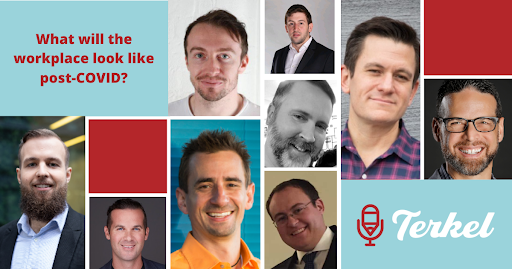A lot of people are wondering if the work-from-home movement will stick, will it be a hybrid, etc. What will the workplace look like post-COVID?
To help you figure out what your workplace will look like post-COVID, we asked business leaders and HR experts this question for their best ideas. From a hybrid environment to less micromanagement, there are several ideas about what the workplace norm will be post-COVID.
Here are nine ideas about what the workplace will look like post-COVID:
• Digital Communication
• WFH Works When It Works
• Back to Normal, With Some Mainstays
• A Hybrid Environment
• 80/20
• The Workforce Personalization Project
• The Hybrid Approach Will Balance Productivity With Cost
• A Collaborative Co-working Space Model
• Less Micromanagement
Digital Communication
Whether a company chooses to go back to a physical workplace or not, the big transformation shift for organizations is around digital communication. All companies will need to adopt secure communications like online faxing because the reality is that not all companies will go back to a physical space. And not only companies but employees may opt for remote environments. Companies will need to adjust their digital communications, no matter how much the new workplace looks like post-COVID.
Eli Patashnik, iFax
WFH Works When It Works
It’s unquestionable that for some employees, working from home every day makes complete sense. They can be even more productive than they would be in an office. It allows them to have a better work-life balance, etc. However, it’s also apparent that for some, it’s important to be in a working environment outside the home, particularly in scenarios where productivity takes a hit due to distraction. I think the hybrid model makes the most sense. Agility in business is king.
Jesse Wilson, GoDaddy
Back to Normal, With Some Mainstays
Our company autonomously makes and sends handwritten notes. Although our robots can write nearly 1,000 notes per day using a real pen, we still need people in our office to mail orders. In 2020, we took big steps to continue business operations in a COVID environment. In the future, our workplace will likely get back to looking like it did in a pre-COVID environment, with a few more mainstays like sanitation stations and increased distancing.
David Wachs, Handwrytten
A Hybrid Environment
Our company has been family-owned and operated since 1985. We attribute our success and longevity to getting the little things right, from listening to our customers to getting better with each and every day. While our success has continued through COVID in a hybrid work environment, we foresee our workplace getting back to normal when things get back to normal. For some companies, going fully work-from-home is just not logistically possible.
Pete Newstrom, Arrow Lift
80/20
Before the pandemic, our company was 80 percent in person and 20 percent remote. After the pandemic, we plan to be 80 percent remote and 20 percent (optional) in person. The pandemic dramatically shifted what our workplace will look like forever. We experienced firsthand how a remote environment can help retain talented employees who relocate or improve productivity for workers who prefer an isolated environment. For businesses with digital components, it’s easy to imagine the same type of shift happening at other companies.
Brett Farmiloe, Markitors
The Workforce Personalization Project
It’s been about a year since the majority of the work world was hit by the pandemic’s tidal wave. As we begin to emerge and catch our breath, it seems rather unlikely that the workplace will return to a 100% 5-day-a-week in-office environment. For many, the last year taught us that work can be done just about anywhere and that the conventional 9–5 workday is not the most optimal strategy. Instead, we seem to be racing towards a full-time adoption of the ultimate workplace personalization project. In this scenario, each team member will have the autonomy and responsibility to choose where and how they accomplish their work. What will matter most is achieving outcomes and results.
Brian Mohr, anthym
The Hybrid Approach Will Balance Productivity With Cost
Working from home arrangements will continue to exist, especially in areas that allow retaining or exceeding baseline productivity. As 2020 had proven the viability of this arrangement for many companies, it pays off to scrap the travel and office rental costs. I believe that in the post-COVID times, many companies will assume a more flexible approach towards it, handing over the choice to their employees.
Michael Sena, Senacea
A Collaborative Co-working Space Model
How much excess capacity exists in current commercial buildings? Most commercial buildings sit vacant for 12 hours out of the working day until the next day begins and 24 hours a day on weekends. If we are collectively reinventing what the new world looks like, we don’t have to use old models that no longer serve the greater good. The co-working model has been gaining ground with entrepreneurs for years. That same entrepreneurial thinking can guide the way for new spaces to optimize the space they need. As a result, we can streamline and maximize the buildings that exist.
Mark Jamnik, Enjoy Life Daily
Less Micromanagement
It’s safe to say that many businesses have seen ample benefits in allowing employees to work from home. There are fewer overheads. Recruitment can be from a wider pool in terms of not having to be based in the local vicinity. And systems are now in place to recruit, monitor and communicate with staff who are working remotely. In terms of staff morale, being able to continue in some form of home working will have some very positive effects. Will everything continue just the way it is? That’s doubtful. Whilst there are great benefits to home working, this isn’t the case in all roles, and when the opportunity arises to return to ‘normal,’ many employers and employees will welcome it. I believe we will see a more flexible approach to working that includes home working, flexible hours, and less micromanagement.
Joe Flanagan, VelvetJobs
Terkel creates community-driven content featuring expert insights. Sign up at terkel.io to answer questions and get published.




